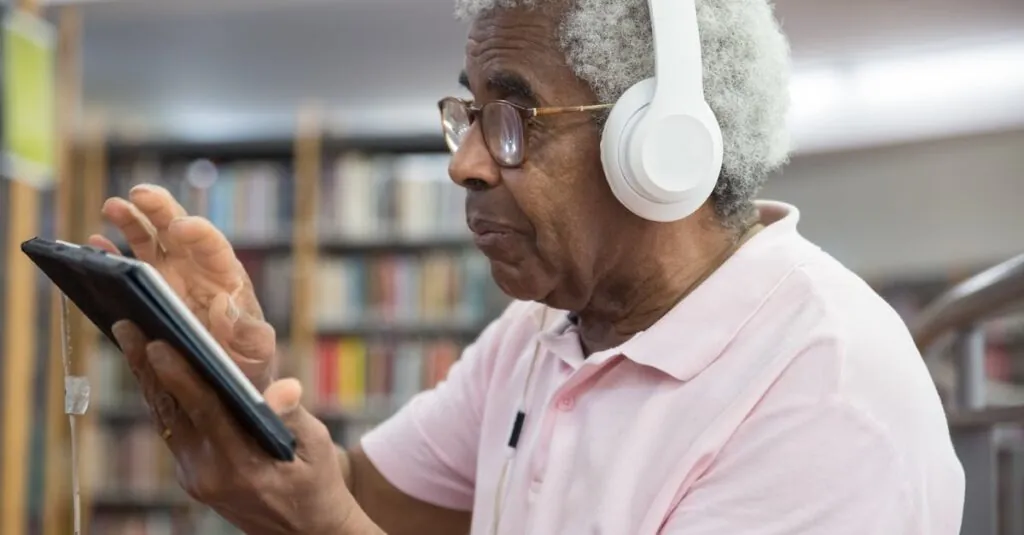Table of Contents
ToggleIn a world where speed often reigns supreme, slow audio training stands out like a tortoise in a race against hares. It’s not about dragging your feet; it’s about savoring every syllable and letting the rhythm of learning sink in. Imagine transforming your listening skills from “what did they just say?” to “I totally got that!” in a way that feels less like a chore and more like a delightful stroll through a park.
Understanding Slow Audio Training
Slow audio training focuses on enhancing listening skills through a deliberate and paced approach to absorbing spoken language. This method fosters a deeper understanding by encouraging learners to fully engage with audio content.
Definition and Concept
Slow audio training involves listening to audio materials at reduced speeds. Learners can target specific areas such as pronunciation, intonation, and vocabulary. Utilizing this method sharpens comprehension, allowing individuals to capture nuances often missed at normal speeds. This practice benefits language learners, musicians, and individuals in auditory fields by fostering a mindful listening experience. Engaging with audio content in a slower context creates opportunities for active participation and reinforces language acquisition.
Historical Context
The practice of slow audio training traces back to language learning traditions. Educators recognized the benefits of slowing down speech for better comprehension. Initially, this concept gained traction with the advent of audio cassettes. In the late 20th century, technology facilitated access to tools that enable listeners to control playback speeds. Recent advancements in digital media provided expanded resources, making slow audio training widely available. Current users now leverage various platforms to enhance their learning experiences significantly.
Benefits of Slow Audio Training
Slow audio training enhances learning experiences by fostering intentional listening. This method offers significant advantages for various learners.
Enhanced Listening Skills
Focused listening improves overall proficiency. Participants engage more actively with audio content, which sharpens attention to detail. This concentrated practice aids in recognizing pronunciation patterns and subtle intonations. Consequently, learners develop the ability to discern sounds and speech variations. Evidence shows improved listening skills also lead to better communication abilities, enhancing interactions in diverse environments. By prioritizing auditory engagement, individuals become more adept at understanding spoken language nuances.
Improved Comprehension
Comprehension benefits from a slower pace of learning. When learners listen at reduced speeds, they absorb information more thoroughly. Specific vocabulary and context become clearer, aiding in retention and recall. Studies indicate that slower audio helps bridge gaps in understanding, making complex language structures accessible. This clarity fosters confidence in language acquisition, encouraging participants to tackle more challenging material. Overall, improved comprehension equips learners with essential tools to succeed in auditory-related fields and everyday conversations.
Techniques for Implementing Slow Audio Training
Implementing slow audio training requires careful consideration and the right tools. Educators and learners can create effective experiences by choosing appropriate resources.
Selecting the Right Material
Choose materials that align with language goals. Audiobooks, podcasts, and language learning programs often serve well. Focus on content that challenges yet motivates. Incorporate diverse subjects, enhancing engagement while developing skills. Selecting native speaker recordings benefits pronunciation practice. Additionally, ensure the material suits the learner’s proficiency level. By aligning content with interests, learners remain committed, promoting long-term engagement.
Tools and Resources
Utilize technology to facilitate slow audio training. Applications like Audacity or VLC Media Player allow users to adjust playback speeds effortlessly. Many language learning platforms include built-in features for slow audio playback. Online resources provide a wide array of audio files compatible with various levels. Podcasts tailored for language learners often offer transcripts, enabling learners to follow along. Explore options that enhance understanding and enjoyment during training sessions. Investing in suitable tools simplifies the process, ensuring effective learning outcomes.
Challenges and Limitations
Slow audio training offers several challenges that learners may face during their journey.
Potential Frustrations
Learning at a slower pace often leads to frustration for many individuals. They might feel impatience as it contrasts sharply with the fast-paced environment prevalent in today’s society. Some learners struggle to maintain focus, finding that they miss enjoying the content due to delays in tempo. Additionally, technical issues may arise; for example, adjusting playback speeds can sometimes be cumbersome with certain applications. Adjusting to slower audio might appear tedious initially, especially when accustomed to normal speeds. Learners may perceive a lack of progress, which can discourage continued engagement. These challenges highlight the importance of perseverance and patience throughout the process.
Overcoming Barriers
Many strategies exist to help learners overcome barriers related to slow audio training. Selecting materials that pique interest significantly aids in maintaining motivation. Engaging with varied content like music, podcasts, or audiobooks keeps the experience fresh and enjoyable. Setting realistic goals provides learners with achievable milestones, fostering a sense of accomplishment as they progress. Collaborating with peers or forming study groups encourages accountability and provides support. For those who struggle with technology, tutorials can demystify complicated playback adjustments. Emphasizing consistency over speed allows learners to appreciate gradual improvement in their skills, ultimately enhancing their engagement and effectiveness in the training process.
Slow audio training offers a refreshing approach to mastering listening skills. By embracing a slower pace learners can truly immerse themselves in the nuances of spoken language. This method not only enhances comprehension but also fosters a deeper connection with the material.
As individuals navigate the challenges of modern life they can find joy in this mindful practice. With the right tools and resources slow audio training becomes an engaging experience rather than a chore. By prioritizing intentional listening and consistent practice learners can unlock their potential and enjoy the journey of language acquisition.




